
|
NEWSLETTER #62 - MARCH 2008
Members will have noticed that the US pages sometimes carry an earlier date than the main newsletter. This is because the US page is added to the main paper newsletter when it is circulated in the US in arrear of the UK edition, so it is actually published between UK paper editions.
Page 1 | Page 2
The jets came before the colour as evidenced by the TCA DC-8 shown in December. In the same series from Valentine there were a BOAC 707 and, surprisingly, a United Caravelle. Presumably it just happened to be passing through on delivery when the photo session was in progress. The TCA DC-8 and BOAC 707 also appear together with a SAS CV440 and KLM DC-8, with a central piper, on a five view card .
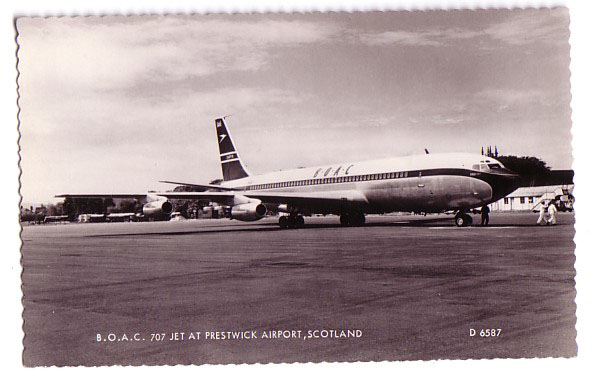
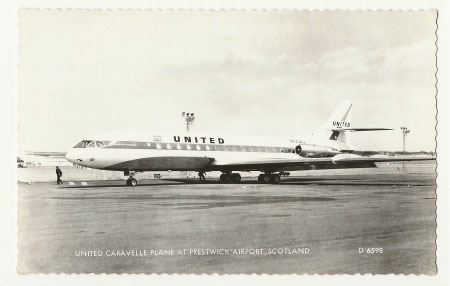
The old terminal/tower made at least one appearance in colour on this card by Dixon. Mailed in 1960 the writer refers to “having a look round this place – takes me back a few years”

The first appearance of the new terminal was on a card issued by a hotel, the Towans hotel, shown in the foreground . Two DC-3s can be seen on the ramp. The first colour jets were also vertical with BOAC and PanAm 707s plus an Air Canada DC-8 on this one from Photo Precision. The DC-8 is in front of the transplanted Glasgow Exhibition Engineering building.
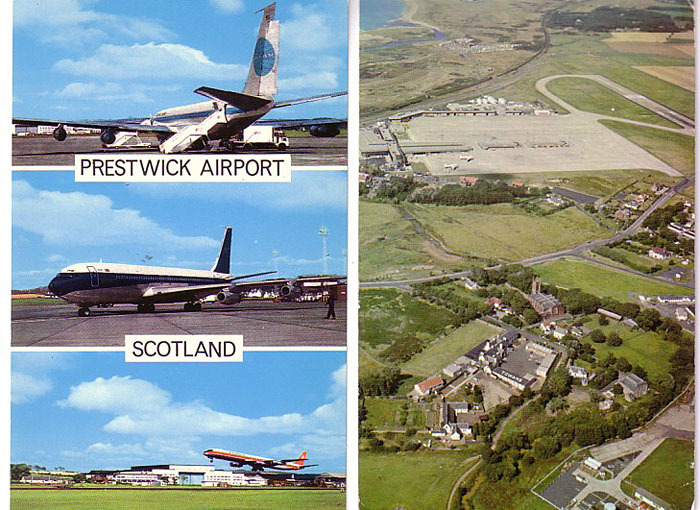
The new terminal gave rise to a number of cards of the interior and landside featuring the furniture and cars of the period. These were by Photo Precision and Valentine. Valentine also produced a set of airliner cards featuring DC-8s of SAS, KLM,PanAm and Air Canada together with a BOAC 707 and Comet 4. The Comet 4 is only

From this era there are also cards in two sizes from Dalling & Henderson of a KLM DC-8 and a ramp view from Hail caledonia including BOAC 707, SAS Caravelle, Ministry of Aviation Dove and Prince, unidentified Herons and a Cessna 310

With the coming of long range jets, traffic at Prestwick was reduced to that serving the Scottish market as the airport remained designated the long haul airport for Glasgow. From this time are two cards featuring 747s. The Pan Am 747 is by Hail Caledonia and also has in the background a short-body Ex Qantas Laker 707 being operated for Barbadan carrier Caribbean. Below a Northwest 747 accompanies DC-8s from US carrier Arrow Air and Canadian Quebecair on Dixon L6/SP7776 where the SP indicates that it was produced for a special customer, presumably the airport.
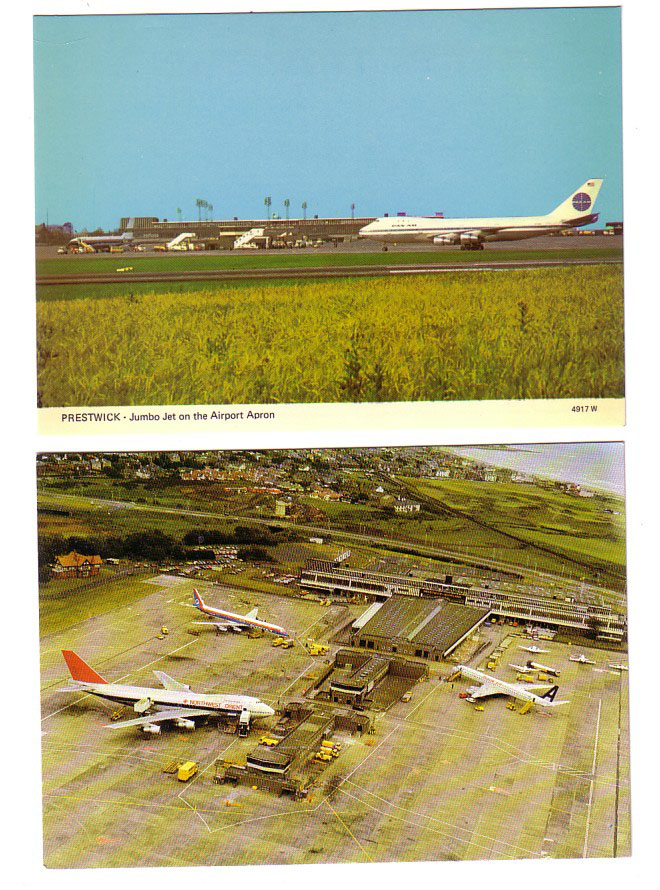
While the emphasis has been on Prestwick as a civil airport , its military connections go back to WWII and it continued to have major USAF activity afterwards. The Valentine new terminal series included one special card for use at , and showing, the US military transport service MATS own terminal.

Resident company Scottish Aviation progressed from a training and repair organisation through to design and manufacture of its own Pioneer and Twin Pioneer aircraft and later took over the Bulldog and Jetstream from Beagle and Handley Page respectively. In 1983 a set of cards was produced for the 25th anniversary of the company, by then part of B.Ae. This view, distorted by the camera angle is of two cards from that set.

Apart from retrospective airport views from among others, Carl McQuaide that ends the Prestwick postcard story. The airport’s latest incarnation, as the Ryanair base for Glasgow remains unrecorded.
By Leonardo Pinzauti, Firenze, Italy
SAIDE – Services Aeriens Internationeaux d Egypte was formed in February 1948 , the majority of the capital being subscribed by the Misr Bank. The remaining shares were controlled by two Italian aircraft companies : Cantieri Aeronavali of Venice – now a maintenance company but previously the designer and builder of a range of seaplanes, and SIAI Marchetti, heir to the Savoia – Marchetti company and its range of trimotors. Both provided technical and field assistance together with the existing Egyptian airline, Misr Airwork. – alias Misrair. As Misrair was a domestic and regional carrier, SAIDE planned to operate services to continental Europe and the Mediterranean basin.
The selection of aircraft was clearly influenced by the partners and two Italian types were selected – 4 three engined FIAT G.212’s and 5 four engined SIAI-Marchetti SM.95s. Although the best thatt Italy could offer, both were essentially pre war in their design and technology. The Fiats were delivered in 1948 and were of the CP “Monterosa” model with 26 / 38 seats. The SM95 fleet was complete by mid 1950. SAIDE issued this postcard of an SM95.
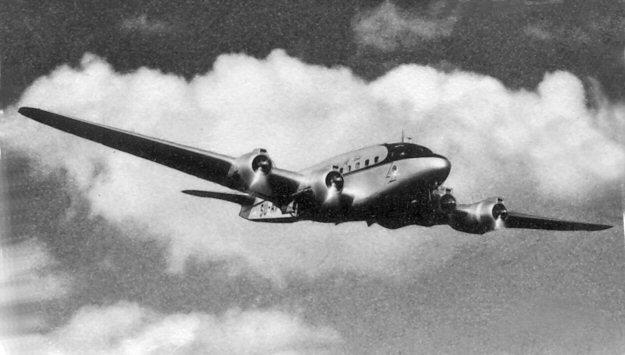
In summer 1948 SAIDE commenced a 1350 mile route to Rome via Alexandria and Athens. In the following year this was extended to Paris and a Libyan route opened to Tripoli and Benghazi., via Alexandria. In 1950 the Paris route was reactivated with a stop at Milan and the Libyan route extended to Tunis. In 1951 service was extended to Munich and Frankfurt. So, by Spring 1952 SAIDE had unduplicated route mileage of 3000.
In the meantime the carrier had sought a newer and more reliable type. The USAF had surplus stocks of Curtiss C-46’s stored in Egypt and six were purchased. Ten years after the war end these C-46s were still being sold from desert stores and many passed through Heathrow on their way to the USA. SAIDE took at least three between 1949 and 1951. The future of SAIDE was, however, to be determined by politics. In July 1952 the Egyptian monarchy was overthrown by the “Free officers” movement. In the consequent economic changes SAIDE was progressively merged into Misrair and all operations had ceased by 1953 and the company went into voluntary liquidation in December of that year. The Italian built fleet was sold in Egypt but had little use thereafter. The Fiat G.12 – predecessor of the G.212, and the SM95 were both used by Alitalia and shown on the familiar history series of cards .
Leonardo’s piece , plus the Egyptair anniversary DH Moth card issued this year, suggested a look at further cards with an Egyptian theme.
More Misr-Airwork Moths SU-AAH and ABO are shown on this card of Alexandria – Dehala Aerodrome by a local Greek? Photographer Grivas. There is also postal history interest as it was sent from carrier HMS Glorius and has a London postcard “Received from HM Ships” with a 1937 date.
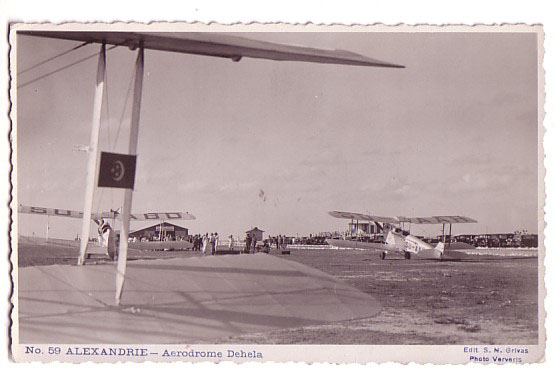
The RAF also had a presence in Egypt with the Cairo base being at Heliopolis. A postcard-backed photo from there has the back text “ Cape to Cairo Flight Fairey IIID s”. This would have been the return flight to the Cape by a flight of Navy Fairey IIID s in 1926 . On the return leg the the flight departed Heliopolis for Aboukir where the wheels were exchanged for floats for the return to Lee-on-Solent.

Cards from the same source show a motley collection of ancient aircraft such as Bristol F2B’s and Avro 504’s apparently still in service in the 1930’s. Not surprisingly many cards feature wrecks . Even more modern types also succumbed such as this early mark Bristol Blenheim – the desert sand in which it has landed may well have played in part in bringing it down.

Egypt was a front line in WW2 , initially against Italian and later German forces. This artist card of a Wellington appears to have been produced in the Middle East for propaganda purposes. If we have any Arabic readers, the back text is shown .
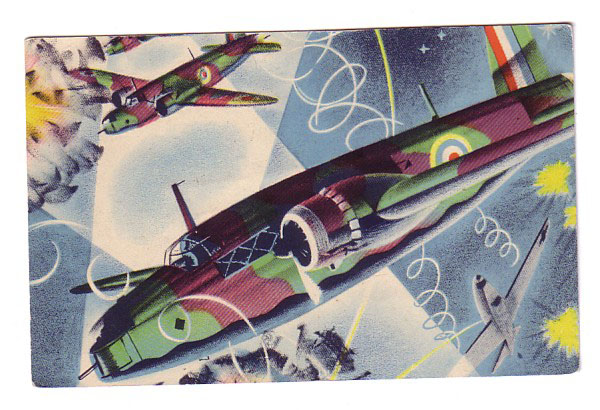

If SAIDE was Italian connected, so Misr-Airwork/Misrair had British and French connections which resulted in purchase of fleets of Vickers Vikings and Sud-Est Languedocs. Misrair issued cards showing the French 4 engined transport edited over various landmarks – in this case the inevitable pyramids. This one was mailed to a boy in Sweden with a message in English from his mother who was in flight Baghdad-Cairo 1955.
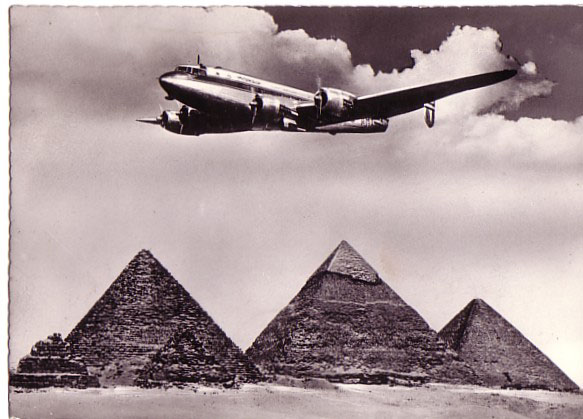
Also written in flight, this time Tunis to Tripoli, this card was mailed to the US with a US forces postmark, presumably from a Libyan base . is this remarkably non-PC, PC from Misrair with an approximation of a Viking.

When Egypt and Syria formed the United Arab Republic, Misrair became United Arab Airlines. Misrair had ordered Comet 4 s and produced this artist card with the obligatory pyramids.
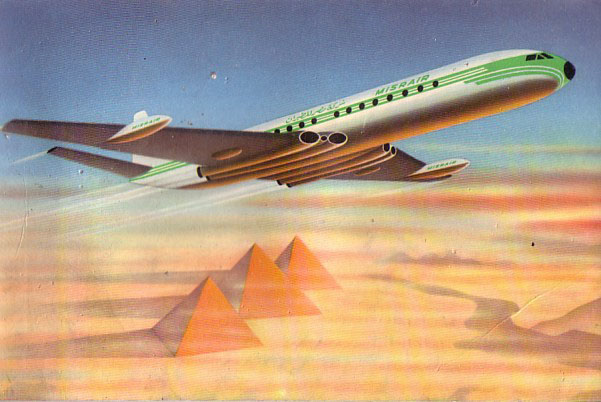
UAA produced two Comet cards of which this is least common. One also featured on a Kruger card of Cairo Airport.

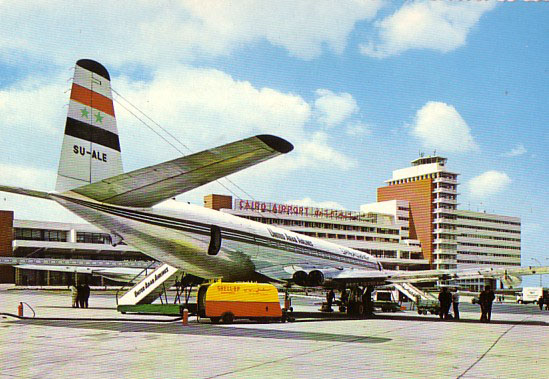
The current Egyptair continues to issue cards but spoilt this A340 by digitally changing the proportions of the long-thin A340 to fit the card, resulting in this bloated version.
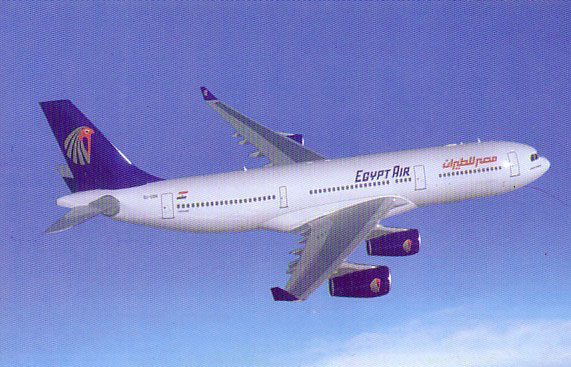
|
 The airline only had one major loss . In October 1949 a G.212 was damaged on take off at Alexandria and further deteriorated from corrosion in open storage and so was written off over a year later.
The airline only had one major loss . In October 1949 a G.212 was damaged on take off at Alexandria and further deteriorated from corrosion in open storage and so was written off over a year later.